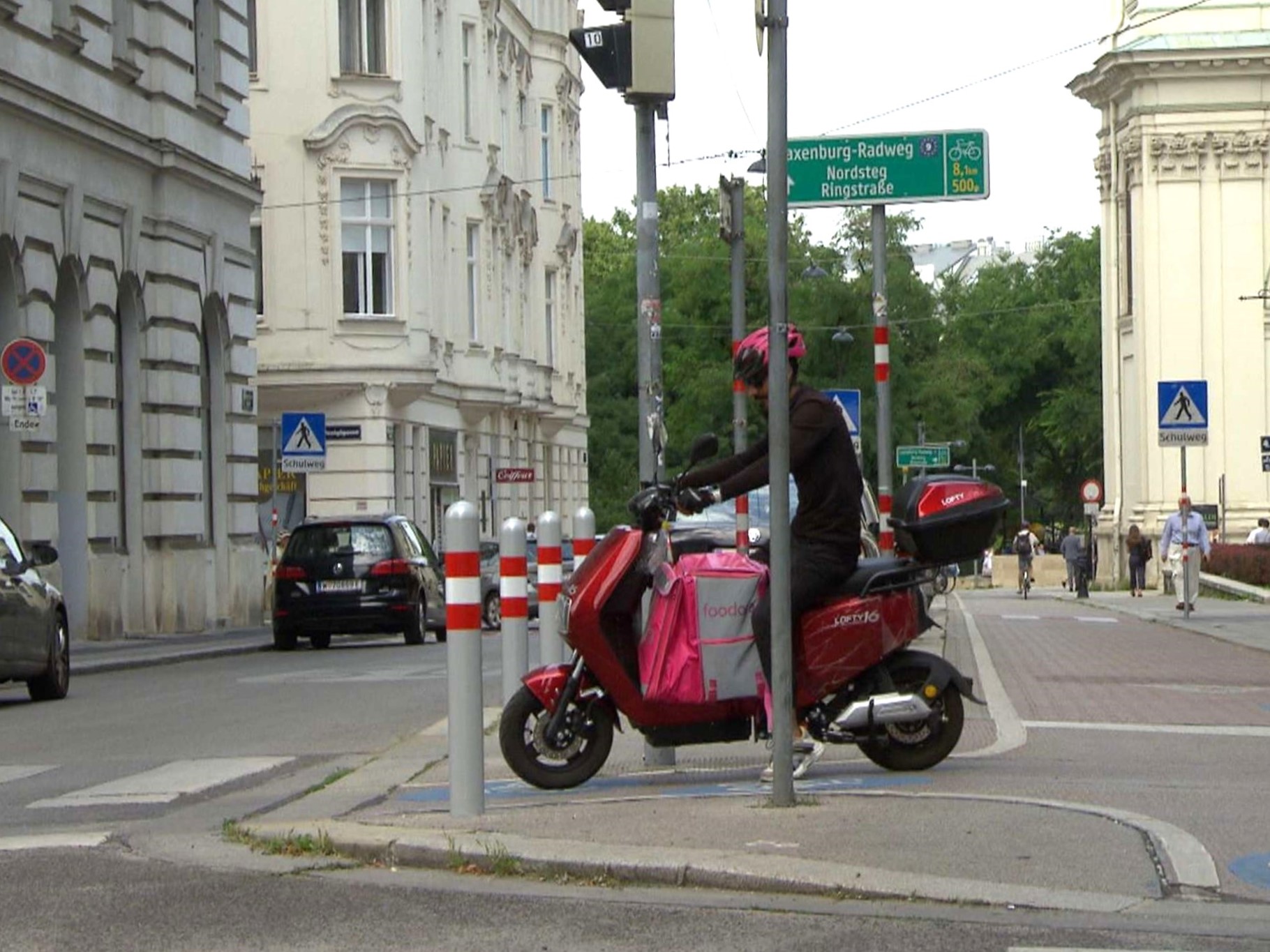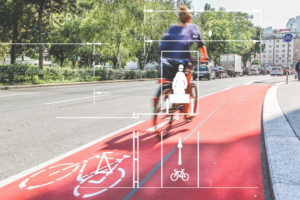Debate about e-scooter, cycle paths and suitable infrastructure

It is no longer just traditional bicycles that can be found on urban cycle paths. Instead, we are increasingly seeing a variety of transport bikes, pedelecs and e-scooters. These varieties of micromobility are legally considered bicycles in Austria and pose major challenges for the capacity of cycling infrastructure. We summarize an in-depth Ö1 radio debate that revolved around the Vienna city government’s proposal to ban so-called “e-mopeds” or e-scooters from cycle paths in order to increase the feeling of safety on cycle paths. Radlobby Austria and the Austrian road safety board KfV took a stand for a more differentiated approach in the radio show on September 5.
City of Vienna wants to enforce new traffic distribution
The city government of Vienna wants to find a legal regulation to increase the feeling of safety on cycle paths in view of the increasing number of e-mopeds. The basis for this is a study by traffic planner Harald Frey from the Institute of Transport Sciences at Vienna University of Technology on speed, road safety and the technical characteristics of different types of vehicles. Frey confirms: “The pressure to use cycle paths is increasing. However, e-mopeds in particular have a massive negative impact on the subjective and objective feeling of safety on cycle paths, mainly due to their weight and driving dynamics”. An average, unmarked e-moped weighs 70 to 80 kg unladen, while a classic moped with a combustion engine weighs just 46 kg. “This makes accidents more dangerous,” says Frey in this article by Radkompetenz member Fahrrad Wien.
Specifically, City Councillor for Transport Ulli Sima (SPÖ) wants the federal government to make a legal distinction between bicycles, electric micro-vehicles and small motorcycles (e.g. e-mopeds). The permitted design speed of 25 km/h should be reduced to 20 km/h for mini e-vehicles on cycle paths. New testing and measurement procedures are required to check these speeds. In addition, vehicles on cycle paths should not exceed an unladen weight of 60 kg. Small motorcycles such as e-mopeds, on the other hand, are to be completely excluded from cycle paths. It is hoped that this regulation will relieve the pressure on cycle paths. Germany could serve as a model, where small electric vehicles such as e-mopeds have to be registered on the road. However, this is based on a different legal definition of a bicycle, as in Germany vehicles must be powered exclusively or predominantly by muscle power in order to be allowed to use the cycle path as a bicycle or pedelec. Maximum motor assistance of up to 25 km/h appliesin both countries.
Desired reallocation of micromobility by the City of Vienna, graphic: Fahrrad Wien. The weight limit of 60 kg in particular is causing displeasure, as it also includes some e-cargobikes.
Opposing voices from Radlobby bicycle advocacy and KFV road safety board
In the radio debate “E-mopeds & Co: off the cycle path?” on Ö1 on September 5, Roland Romano, spokesman of Cycle Competence member Radlobby, and Klaus Robatsch from the road safety board KfV commented on these issues. The Radlobby believes that banning e-mobility of this kind from cycle paths is the wrong approach. Instead, cycle paths should provide a safe space for all forms of muscle and electrically powered micromobility – including e-mopeds. These different forms of micromobility are already part of everyday urban life, and a safe riding experience must also be guaranteed for e-mopeds. Pushing these vehicles onto the road, where they would have to share space with faster motorized private transport, is not a long-term solution.
Klaus Robatsch, Head of Research at KfV, also emphasized the need for high-quality cycling infrastructure in the debate. Sufficiently wide cycle paths would offer all road users enough space and contribute to safety, while cycle paths that are too narrow lead to conflicts and accidents.
Increased investment in cycling infrastructure is needed to adapt cycle paths to the different types of bicycles. According to the basic study “Cycling investment needs” by the Ministry of Climate Protection and the federal states, around 7 billion euros are needed across Austria to create safe and high-quality cycle paths throughout the country.
Roland Romano emphasized: “In the future, we will need many more smaller, lighter, cleaner and quieter vehicles, including these light electric vehicles. Systematic solutions are needed to ensure that those who need protection also have it and that the roads are available to everyone at similar speeds to make it safer for everyone.” Instead of discussing a ban on e-mopeds on cycle paths, there should be a discussion about removing the obligation to use cycle paths. With sufficient investment in cycling infrastructure, it would be good enough to be used voluntarily.
Shared roads at low speeds
The decision as to whether different types of traffic should be separated or mixed depends on how safely the traffic flow can be organized as a result. This is based on the RVS guidelines for cycle traffic, which were revised in 2022. We have explained the changes in this article. Busy cycle traffic facilities that comply with these guidelines can cope with transport bikes or e-mopeds. According to the width specifications of the highest expansion stages of cycle paths according to the RVS, a cargobike or a normal bike can overtake another cargobike.
Klaus Robatsch (KfV) also addressed the lack of speed discipline on the part of drivers: “In traffic planning, it is essential to combine traffic types that have similar speeds. At 30 km/h, it would be good to drive in mixed traffic. However, the prerequisite is that a 30 km/h speed limit is also a 30 km/h speed limit. In Austria people often drive at 40-45 km/h in the 30 km/h zone, and then these speeds no longer fit together.”
In view of these debates and the change in modes of transport, it is clear that sustainable transport planning must increasingly focus on adapting cycling infrastructure and modernizing traffic areas in general in order to do justice to the growing diversity of micromobility. Wide and well-developed cycle paths are crucial for the coexistence of different vehicle types. If electric light vehicles are to supply the low-emission zones of a climate-neutral city and private local mobility becomes even more diverse, classic distribution issues regarding traffic areas will be overtaken by reality.
Ö1 interview with Roland Romano (Radlobby) and Klaus Robatsch (Kuratorium für Verkehrssicherheit): “E-mopeds” & Co: off the cycle path?, 05.09. | Ö1 | ORF-Radiothek | ORF report April 2024
Source header image: ORF screenshot
Cycling Competence Members in this article:
More articles with this member:
[crp]
Share this article:
Debate about e-scooter, cycle paths and suitable infrastructure
Share this article:

It is no longer just traditional bicycles that can be found on urban cycle paths. Instead, we are increasingly seeing a variety of transport bikes, pedelecs and e-scooters. These varieties of micromobility are legally considered bicycles in Austria and pose major challenges for the capacity of cycling infrastructure. We summarize an in-depth Ö1 radio debate that revolved around the Vienna city government’s proposal to ban so-called “e-mopeds” or e-scooters from cycle paths in order to increase the feeling of safety on cycle paths. Radlobby Austria and the Austrian road safety board KfV took a stand for a more differentiated approach in the radio show on September 5.
City of Vienna wants to enforce new traffic distribution
The city government of Vienna wants to find a legal regulation to increase the feeling of safety on cycle paths in view of the increasing number of e-mopeds. The basis for this is a study by traffic planner Harald Frey from the Institute of Transport Sciences at Vienna University of Technology on speed, road safety and the technical characteristics of different types of vehicles. Frey confirms: “The pressure to use cycle paths is increasing. However, e-mopeds in particular have a massive negative impact on the subjective and objective feeling of safety on cycle paths, mainly due to their weight and driving dynamics”. An average, unmarked e-moped weighs 70 to 80 kg unladen, while a classic moped with a combustion engine weighs just 46 kg. “This makes accidents more dangerous,” says Frey in this article by Radkompetenz member Fahrrad Wien.
Specifically, City Councillor for Transport Ulli Sima (SPÖ) wants the federal government to make a legal distinction between bicycles, electric micro-vehicles and small motorcycles (e.g. e-mopeds). The permitted design speed of 25 km/h should be reduced to 20 km/h for mini e-vehicles on cycle paths. New testing and measurement procedures are required to check these speeds. In addition, vehicles on cycle paths should not exceed an unladen weight of 60 kg. Small motorcycles such as e-mopeds, on the other hand, are to be completely excluded from cycle paths. It is hoped that this regulation will relieve the pressure on cycle paths. Germany could serve as a model, where small electric vehicles such as e-mopeds have to be registered on the road. However, this is based on a different legal definition of a bicycle, as in Germany vehicles must be powered exclusively or predominantly by muscle power in order to be allowed to use the cycle path as a bicycle or pedelec. Maximum motor assistance of up to 25 km/h appliesin both countries.
Desired reallocation of micromobility by the City of Vienna, graphic: Fahrrad Wien. The weight limit of 60 kg in particular is causing displeasure, as it also includes some e-cargobikes.
Opposing voices from Radlobby bicycle advocacy and KFV road safety board
In the radio debate “E-mopeds & Co: off the cycle path?” on Ö1 on September 5, Roland Romano, spokesman of Cycle Competence member Radlobby, and Klaus Robatsch from the road safety board KfV commented on these issues. The Radlobby believes that banning e-mobility of this kind from cycle paths is the wrong approach. Instead, cycle paths should provide a safe space for all forms of muscle and electrically powered micromobility – including e-mopeds. These different forms of micromobility are already part of everyday urban life, and a safe riding experience must also be guaranteed for e-mopeds. Pushing these vehicles onto the road, where they would have to share space with faster motorized private transport, is not a long-term solution.
Klaus Robatsch, Head of Research at KfV, also emphasized the need for high-quality cycling infrastructure in the debate. Sufficiently wide cycle paths would offer all road users enough space and contribute to safety, while cycle paths that are too narrow lead to conflicts and accidents.
Increased investment in cycling infrastructure is needed to adapt cycle paths to the different types of bicycles. According to the basic study “Cycling investment needs” by the Ministry of Climate Protection and the federal states, around 7 billion euros are needed across Austria to create safe and high-quality cycle paths throughout the country.
Roland Romano emphasized: “In the future, we will need many more smaller, lighter, cleaner and quieter vehicles, including these light electric vehicles. Systematic solutions are needed to ensure that those who need protection also have it and that the roads are available to everyone at similar speeds to make it safer for everyone.” Instead of discussing a ban on e-mopeds on cycle paths, there should be a discussion about removing the obligation to use cycle paths. With sufficient investment in cycling infrastructure, it would be good enough to be used voluntarily.
Shared roads at low speeds
The decision as to whether different types of traffic should be separated or mixed depends on how safely the traffic flow can be organized as a result. This is based on the RVS guidelines for cycle traffic, which were revised in 2022. We have explained the changes in this article. Busy cycle traffic facilities that comply with these guidelines can cope with transport bikes or e-mopeds. According to the width specifications of the highest expansion stages of cycle paths according to the RVS, a cargobike or a normal bike can overtake another cargobike.
Klaus Robatsch (KfV) also addressed the lack of speed discipline on the part of drivers: “In traffic planning, it is essential to combine traffic types that have similar speeds. At 30 km/h, it would be good to drive in mixed traffic. However, the prerequisite is that a 30 km/h speed limit is also a 30 km/h speed limit. In Austria people often drive at 40-45 km/h in the 30 km/h zone, and then these speeds no longer fit together.”
In view of these debates and the change in modes of transport, it is clear that sustainable transport planning must increasingly focus on adapting cycling infrastructure and modernizing traffic areas in general in order to do justice to the growing diversity of micromobility. Wide and well-developed cycle paths are crucial for the coexistence of different vehicle types. If electric light vehicles are to supply the low-emission zones of a climate-neutral city and private local mobility becomes even more diverse, classic distribution issues regarding traffic areas will be overtaken by reality.
Ö1 interview with Roland Romano (Radlobby) and Klaus Robatsch (Kuratorium für Verkehrssicherheit): “E-mopeds” & Co: off the cycle path?, 05.09. | Ö1 | ORF-Radiothek | ORF report April 2024
Source header image: ORF screenshot
Cycling Competence Members in this article:
More articles with this member:
[crp]



